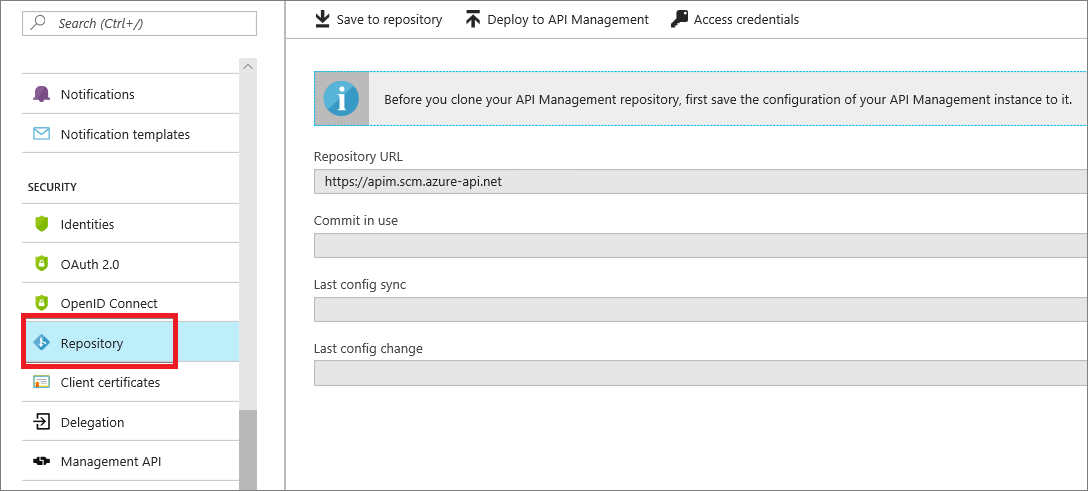/**
* This script automates deployments between developer portal instances.
* In order to run it, you need to:
*
* 1) Clone the api-management-developer-portal repository:
* git clone https://github.com/Azure/api-management-developer-portal.git
*
* 2) Install NPM packages:
* npm install
*
* 3) Run this script with a valid combination of arguments:
* node ./migrate ^
* --sourceSubscriptionId "< your subscription ID >" ^
* --sourceResourceGroupName "< your resource group name >" ^
* --sourceServiceName "< your service name >" ^
* --sourceTenantId "< optional (needed if source and destination is in different subscription) source tenant ID >" ^
* --sourceServicePrincipal "< optional (needed if source and destination is in different subscription) source service principal or user name. >" ^
* --sourceServicePrincipalSecret "< optional (needed if source and destination is in different subscription) secret or password for service principal or az login for the source apim. >" ^
* --destSubscriptionId "< your subscription ID >" ^
* --destResourceGroupName "< your resource group name >" ^
* --destServiceName "< your service name >"
* --destTenantId "< optional (needed if source and destination is in different subscription) destination tenant ID >"
* --destServicePrincipal "< optional (needed if source and destination is in different subscription)destination service principal or user name. >"
* --destServicePrincipalSecret "< optional (needed if source and destination is in different subscription) secret or password for service principal or az login for the destination. >"
*
* Auto-publishing is not supported for self-hosted versions, so make sure you publish the portal (for example, locally)
* and upload the generated static files to your hosting after the migration is completed.
*
* You can specify the SAS tokens directly (via sourceToken and destToken), or you can supply an identifier and key,
* and the script will generate tokens that expire in 1 hour. (via sourceId, sourceKey, destId, destKey)
*/
const { ImporterExporter } = require('./utils.js');
const yargs = require('yargs')
.example(`node ./migrate ^ \r
* --sourceSubscriptionId "< your subscription ID > \r
* --sourceResourceGroupName "< your resource group name > \r
* --sourceServiceName "< your service name > \r
* --sourceTenantId "< optional (needed if source and destination is in different subscription) source tenant ID > \r
* --sourceServicePrincipal "< optional (needed if source and destination is in different subscription) source service principal or user name. > \r
* --sourceServicePrincipalSecret "< optional (needed if source and destination is in different subscription) secret or password for service principal or az login for the source apim. > \r
* --destSubscriptionId "< your subscription ID > \r
* --destResourceGroupName "< your resource group name > \r
* --destServiceName "< your service name > \r
* --destTenantId "< optional (needed if source and destination is in different subscription) destination tenant ID > \r
* --destServicePrincipal "< optional (needed if source and destination is in different subscription) destination service principal or user name. > \r
* --destServicePrincipalSecret "< optional (needed if source and destination is in different subscription) secret or password for service principal or az login for the destination. >\n`)
.option('sourceSubscriptionId', {
type: 'string',
description: 'Azure subscription ID.',
demandOption: true
})
.option('sourceResourceGroupName', {
type: 'string',
description: 'Azure resource group name.',
demandOption: true
})
.option('sourceServiceName', {
type: 'string',
description: 'API Management service name.',
demandOption: true
})
.option('sourceTenantId', {
type: 'string',
description: 'source tenant ID.',
demandOption: false
})
.option('sourceServicePrincipal', {
type: 'string',
description: 'source service principal ID.',
demandOption: false
})
.option('sourceServicePrincipalSecret', {
type: 'string',
description: 'source service principal secret.',
demandOption: false
})
.option('destSubscriptionId', {
type: 'string',
description: 'Azure subscription ID.',
demandOption: true
})
.option('destResourceGroupName', {
type: 'string',
description: 'Azure resource group name.',
demandOption: true
})
.option('destServiceName', {
type: 'string',
description: 'API Management service name.',
demandOption: true
})
.option('destTenantId', {
type: 'string',
description: ' destination tenantId.',
demandOption: false
})
.option('destServicePrincipal', {
type: 'string',
description: 'destination service principal or user name.',
demandOption: false
})
.option('destServicePrincipalSecret', {
type: 'string',
description: 'destination service principal secret.',
demandOption: false
})
.help()
.argv;
async function migrate() {
try {
const sourceImporterExporter = new ImporterExporter(yargs.sourceSubscriptionId, yargs.sourceResourceGroupName, yargs.sourceServiceName, yargs.sourceTenantId, yargs.sourceServicePrincipal, yargs.sourceServicePrincipalSecret);
await sourceImporterExporter.export();
const destImporterExporter = new ImporterExporter(yargs.destSubscriptionId, yargs.destResourceGroupName, yargs.destServiceName, yargs.destTenantId, yargs.destServicePrincipal, yargs.destServicePrincipalSecret);
await destImporterExporter.cleanup();
await destImporterExporter.import();
await destImporterExporter.publish();
}
catch (error) {
throw new Error(`Unable to complete migration. ${error.message}`);
}
}
migrate()
.then(() => {
console.log("DONE");
process.exit(0);
})
.catch(error => {
console.error(error.message);
process.exit(1);
});

